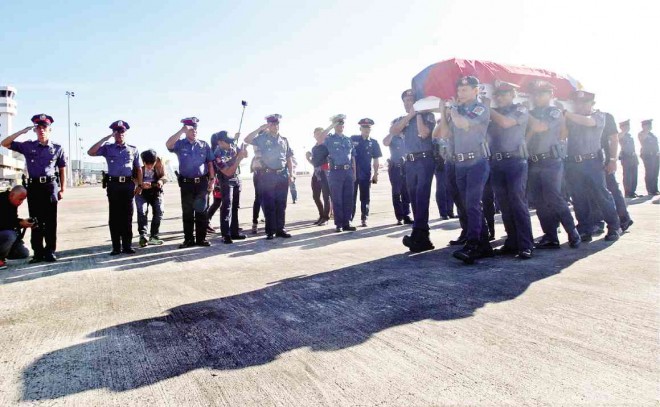
A COFFIN bearing the remains of one of the Fallen 44 SAF men arrive at the Mactan Cebu International Airport, casting a shadow on the airport tarmac and on the continuing effort by the Aquino administration to preserve the gains of the peace process with Moro Islamic Liberation Front. JUNJIE MENDOZA/CEBU DAILY NEWS
ZAMBOANGA CITY—Military officers and troops are citing a Feb. 15 clash between Army soldiers and members of the terror group Abu Sayyaf in Basilan province as an example of how proper coordination could save lives in battle.
The fight in Al-Barka town, according to soldiers and officers who took part in it, could have been a debacle similar to the Jan. 25 bloodbath that saw 44 police commandos, 18 guerrillas and five civilians dead in Mamasapano town in Maguindanao province.
Timely reinforcement and more firepower saved the day for the Army, according to one of the soldiers.
“Had it not been for the immediate reinforcement, it would have become a free-for-all,” said Pfc Melchor Solayao of the Army’s 87th Infantry Battalion.
Solayao said his team had served as a support group for lead teams operating against the Abu Sayyaf group led by Basir Kasaran.
At dawn of Feb. 15, he said his platoon proceeded to Kuhon Lenuh in Al-Barka.
“We were about 20 to 25 meters from the target when the encounter took place. It was still dark then,” he said.
Pfc Reynaldo Taroy Jr. of the the 61st Reconnaissance Company said that during the first few minutes of battle, the number of Abu Sayyaf men was not big, but as hours passed, it went up to about a hundred.
All of them were well-equipped, Taroy said.
“This was when we decided to ask for reinforcement and air support,” he said.
By this time, three soldiers from the first team and three more from the second were already wounded.
“The volume of fire from the Abu Sayyaf was great, it seemed they were not running out of bullets. We could not keep up with them,” Solayao said.
Rear Admiral Reynaldo Yoma, commander of the Naval Forces Western Mindanao and overall head of the Joint Task Force Zambasulta (Zamboanga, Basilan, Sulu and Tawi-Tawi), said Army officials quickly sent air and naval support and more soldiers.
Taroy said attack helicopters arrived at the clash site around
10 a.m., “but there were wounded soldiers and the bandits started shooting at the helicopters.”
The air strike was aborted, he said.
According to Yoma, one of the helicopters, an MG-520, was hit by sniper fire but suffered only minor damage.
The arrival of more troops from the 13th Scout Ranger Company and 18th Infantry Battalion, and naval support forced the Abu Sayyaf to retreat, according to Yoma.
Solayao and Taroy said had the reinforcement failed to arrive on time, the bandits could have slaughtered the soldiers.
In the aftermath of the clash, six soldiers and five civilians, including two children, suffered shrapnel wounds.
Yoma said the civilians are relatives of Kasaran, the Abu Sayyaf group leader.
“They were not targets but it so happened that they were in the area,” he said. Julie S. Alipala, Inquirer Mindanao